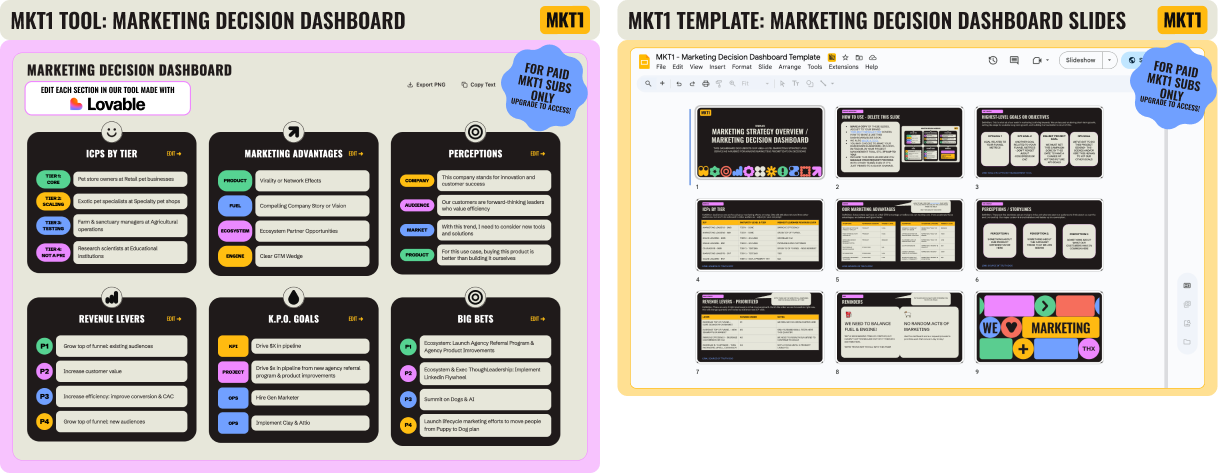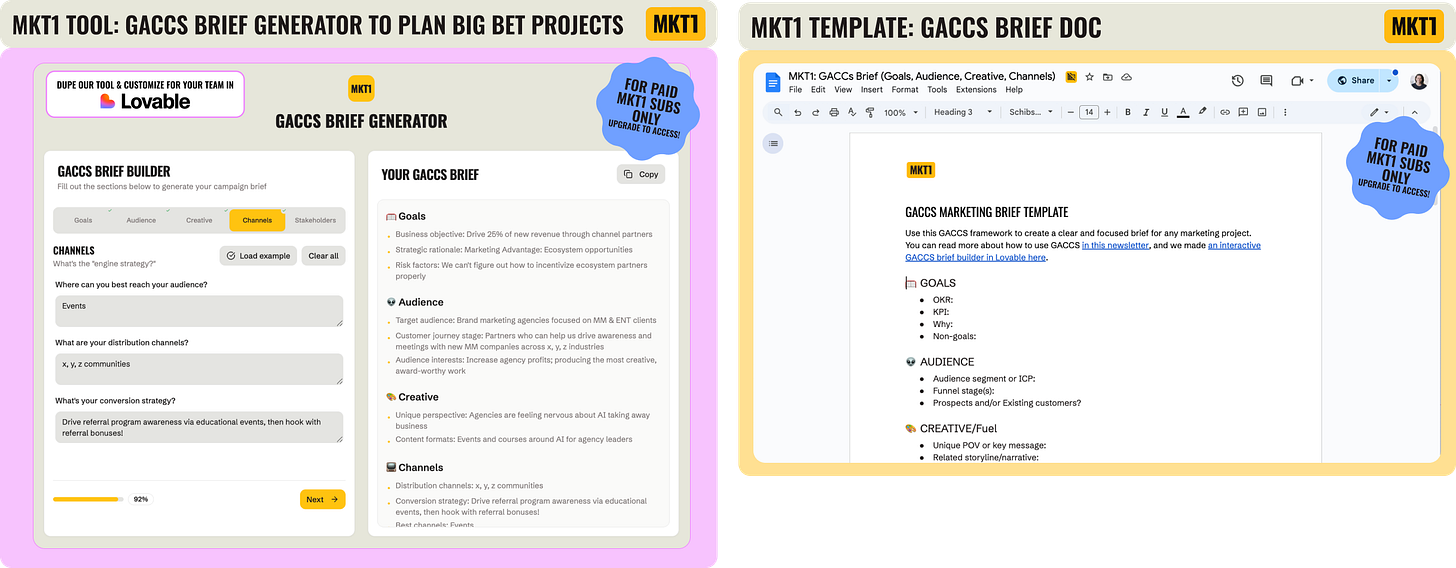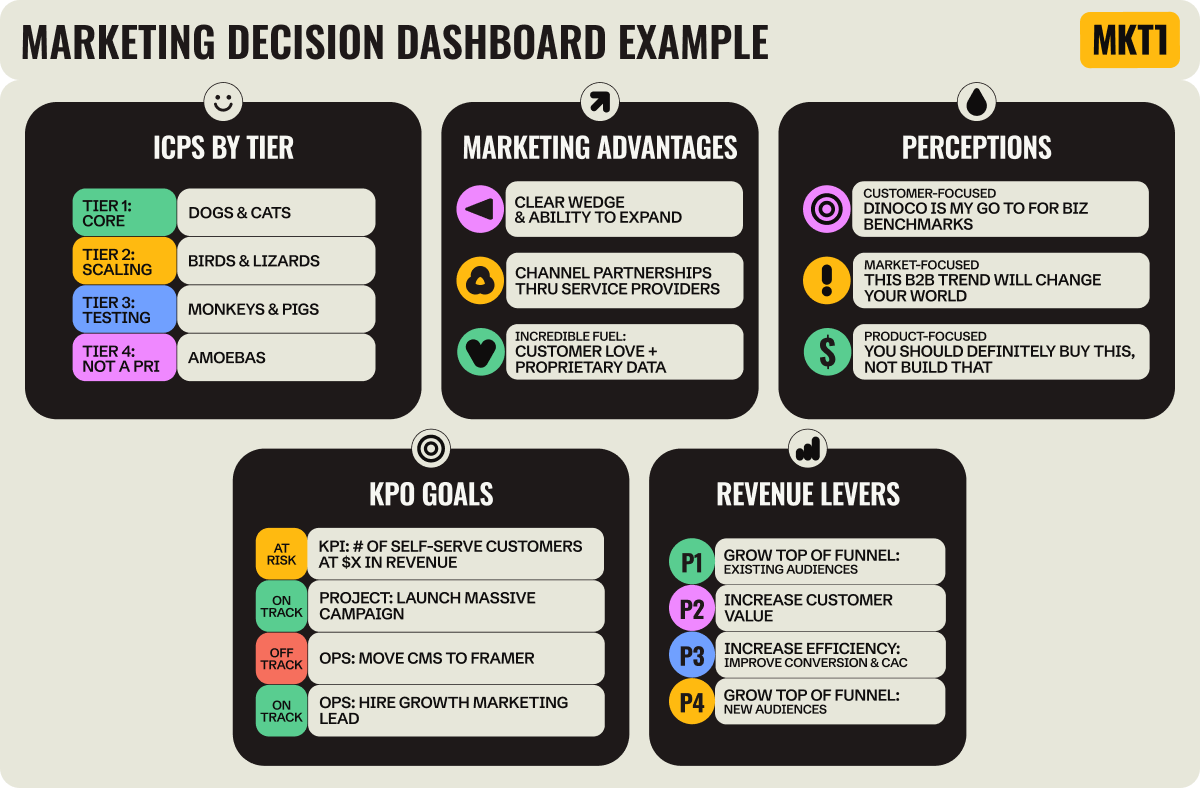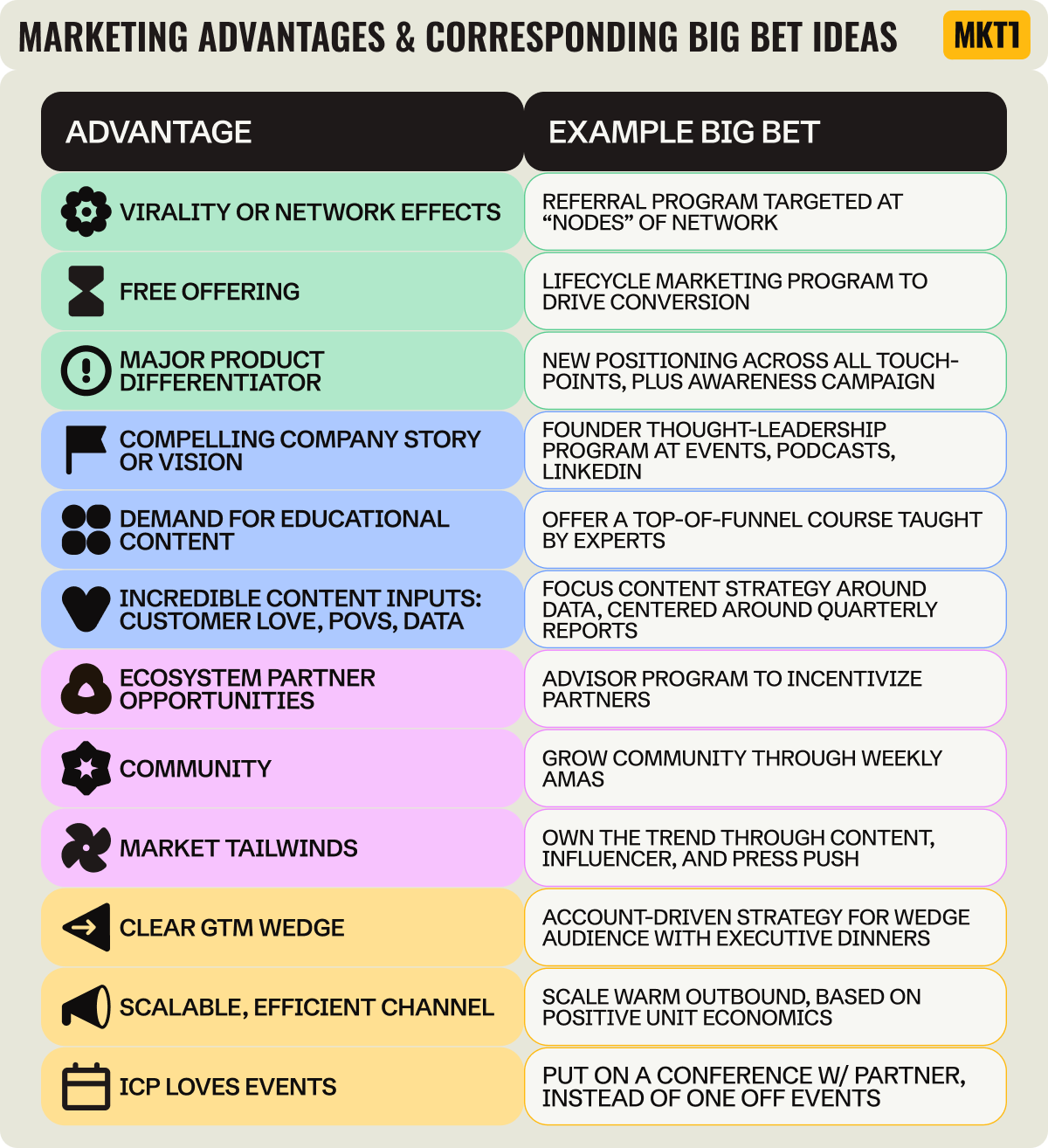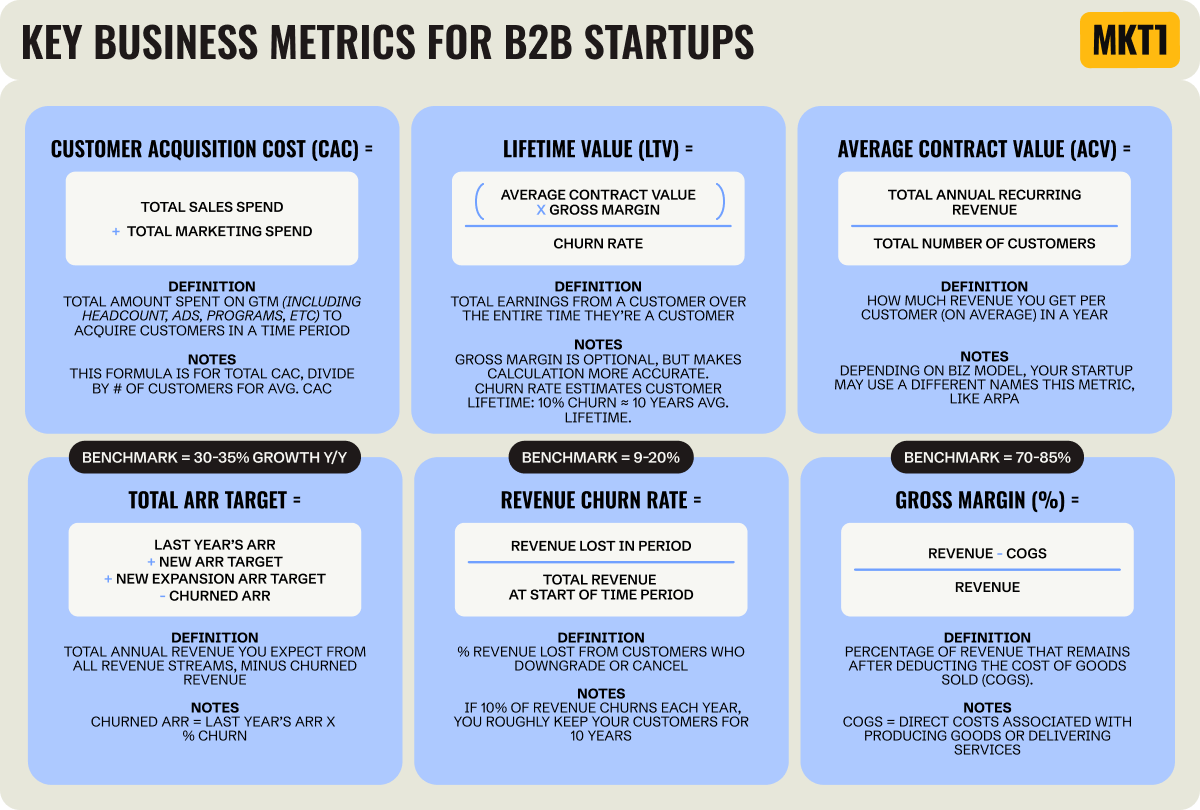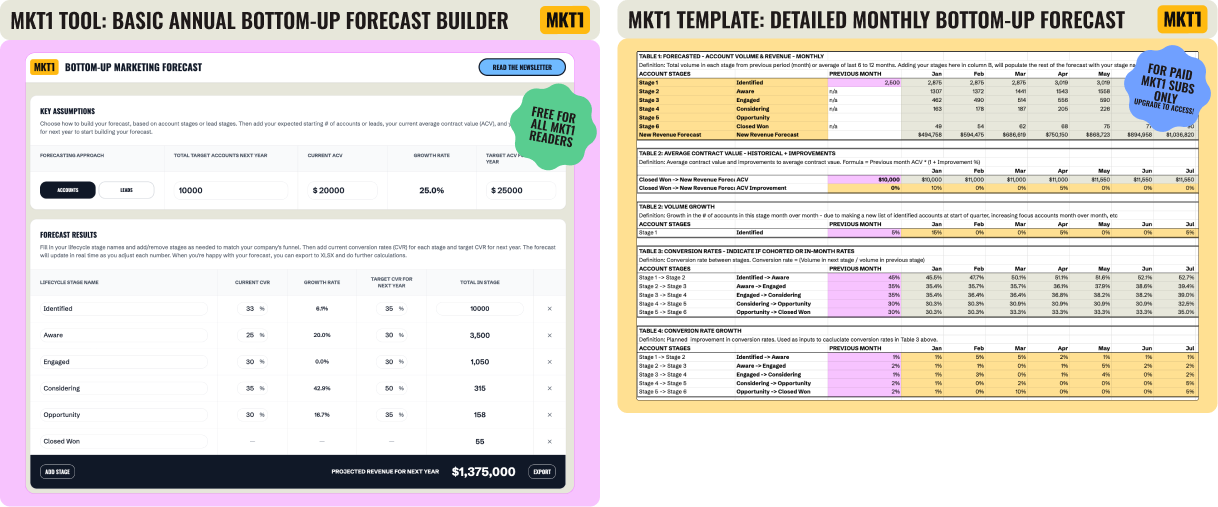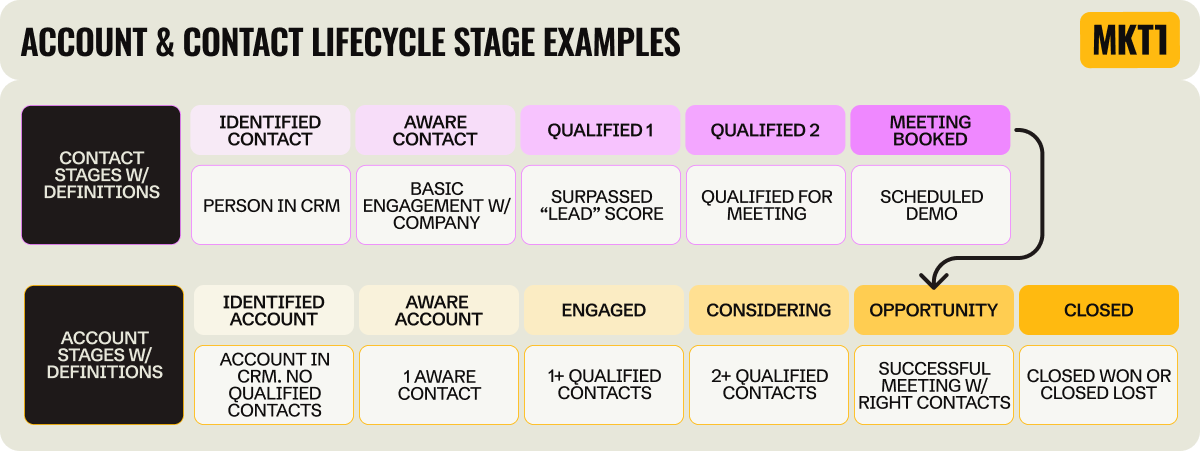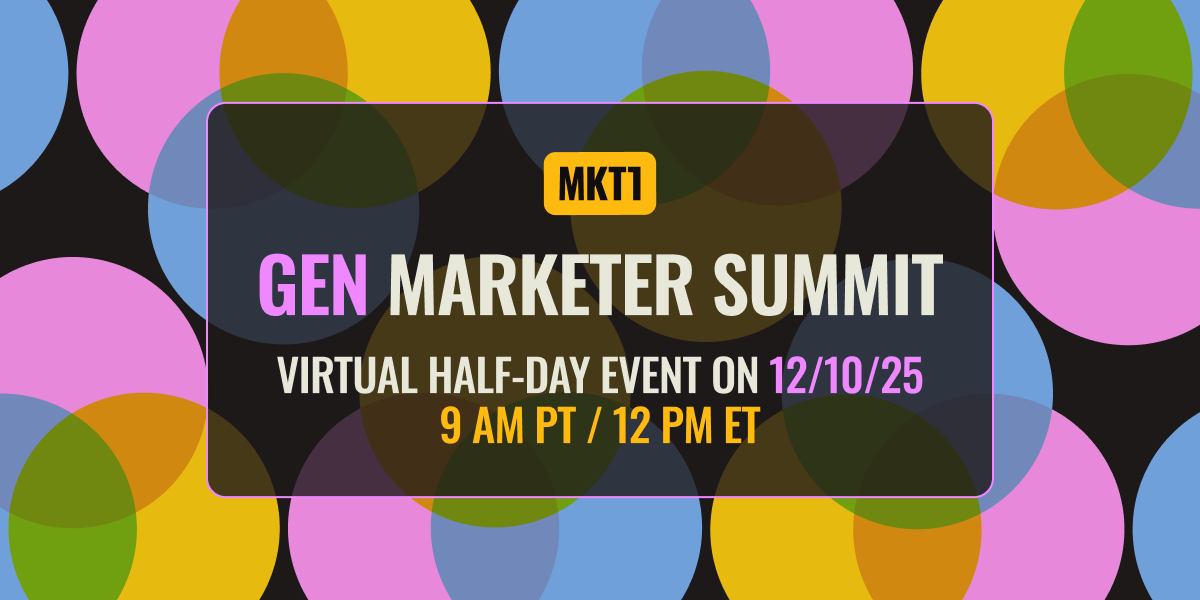How to answer 3 big, scary annual planning questions (in days, not months)
Tools and guidance on how to set a basic forecast and budget range and choose your big bets for next year
👋 This is a monthly free edition of MKT1 Newsletter—a deep dive into a B2B startup marketing topic, brought to you by Profound, Primer, and Closing Media.
Upgrade to a paid subscription to get 100+ templates & resources, a vetted contractor & agency list, free posts on the MKT1 job board, full access to the MKT1 archive, bonus newsletters—and our brand new MKT1 Perk Stack, exclusive discounts for annual paid subscribers.
Annual planning can feel like a herculean task. In fact, I wrote a four-part series on the topic last year; it came in at around 18,000 words. Admittedly, that probably didn’t make the process feel any less daunting.
So this year, I’m taking the opposite approach. I want to help you create a lightweight, first draft of an annual plan—especially if you’re at a smaller startup or working at an AI company where annual planning can feel like a fool’s errand given the pace of change.
You can boil most of marketing planning down to 3 questions you’ve likely already been asked for next year: What will marketing do to drive growth? How much budget does marketing need? Marketing, can you hit this revenue target?! This newsletter and our new tools will help you answer these questions.
Of course, if you want to go deeper after making your lightweight plan, you can still read the full series from last year. But if you want to plan 2025-style, you can use our vibe-coded tools to guide you. Two are totally free, and one’s for paid subscribers. Because my MKT1 2026 annual plan says: make the MKT1 paid subscription even better and more valuable.
In this newsletter:
Answers to the 3 big questions you’ll get asked during annual planning. Here’s the short version:
Question 1: What will marketing do to drive growth next year?
Answer: Plan 3–5 big bets for the year, based on your specific marketing strategy.
New: Marketing Decision Dashboard tool - for paid subs onlyQuestion 2: How much budget does marketing need?
Answer: Start with marketing efficiency metrics to ballpark the right budget range.
Bonus: Budget calculator - free toolQuestion 3: Marketing, can you hit this revenue target?
Answer: Build a bottom-up forecast to see if your top-down target is realistic
Bonus: Forecast estimator - free tool
Plus, how to take these basic planning exercises to the next level of detail
Our new video series, MKT1 Unboxing: Attio
More details about our Gen Marketer Virtual Summit on 12/10/25
Recommended products & agencies
We only include sponsors we’d recommend personally to our community. If you are interested in sponsoring our newsletter, email us at sponsorships@mkt1.co.
Profound helps brands like Ramp, MongoDB, and DocuSign understand and control what AI says about them. With the largest dataset of AI prompts and conversations, Profound generates AI-optimized content in minutes—complete with brand kits, citations, and topic research.
🎁Offer: Use code MKT1 for 20% off Profound Lite (new customers only).
—
Primer: Primer lets you build, enrich, and sync custom B2B audiences using your CRM, CSVs, and Primer’s proprietary datasets, then deploy them across Meta, LinkedIn, Google, Reddit, and DV360 at 40–90% match rates.
🎁Offer: Get 10% off an annual subscription with code MKT110.
—
Closing Media is a boutique agency that runs LinkedIn and Google campaigns for growth-stage startups. They know the best ways to build and scale ad campaigns in 2025 (hint: thought leader ads!) and have years of expertise (I worked with them in 2018!).
🎁Offer: Reach out to Closing Media here & mention MKT1 to get $5,000 of free ad spend for your next campaign.
MKT1 Unboxing: A quick break to unbox Attio
MKT1 Unboxing is our new video series, each video is a 30-minute demo + conversation where I (Emily Kramer) unbox marketing and GTM tools — no slides, no scripts, no sales pitch. Just real tools, real workflows, and real talk. The goal: help you find AI tools worth using.
If you’ve ever opened Salesforce and immediately regretted it, this one’s for you….so basically that’s everyone?!
In our first episode of MKT1 Unboxing, Zev Lebowitz shows why Attio calls their CRM “Customer Relationship Magic.”
I get a full tour of what an AI-native CRM looks like, including how easy it is to build automations, workflows, and reporting, and to sync contacts and accounts in minutes.
Zev also shows how Attio uses Attio to manage partnerships, events, and PLG & enterprise motions in one CRM with ease.
If you need a more flexible CRM that doesn’t try to squeeze you into a box (see what I did there?) watch the video, then get started with Attio here.
Now, on to those scary planning questions (and making them seem a little less scary)…
Question 1: “What will marketing do to drive growth next year?”
Whatever you do, do not answer this question with “We don’t know yet.” If you do, you’ll be flooded with “What if we did X?” and “Have-you-seen-what-this-company-is-doing?” Slacks. That’s a recipe for Random Acts of Marketing (RAM). You need a plan that includes the big bets you’re going to focus on, whether you run content, growth, or the whole marketing show.
So before you jump to a quick answer or start calculating forecasts or budgets, figure out what projects can actually move the needle. To do this, codify and evaluate your marketing strategy, then identify 3–5 big bets for the year.
🪞What the answer looks like
The output here isn’t a laundry list of incremental improvements. Those don’t count, they just keep the lights on.
To truly answer this question, you should share 3–5 big bets, each with its own GACCS Brief™, which stands for Goals, Audience, Creative, Channels, and Stakeholders.
Your big bets should be initiatives that combine Fuel and Engine™ for a specific audience, with a specific goal—and have a strong chance of driving step-change growth.
You should also share your strategic thinking that led to these big bets, for those who want to dive deeper. This can be a one-page strategy doc, I like to use a Marketing Decision Dashboard™.
Getting to the right answer here requires a varying amount of pre-work, depending on how well you’ve defined your marketing strategy already. The steps below will help you zero in on the most useful exercises for identifying big bets.
» But if you need to back up & do a deep dive on your strategy first, the MKT1 Field Guide is a good starting point, as is last year’s annual planning series.
🕹️ MKT1 Tools to get faster, better answers
We vibe-coded tools to build your Marketing Decision Dashboard and generate GACCS Briefs, both available for paid subscribers. Use these tools while you go through the steps below to get to a quick (and beautiful!) result.
We also have a Marketing Decision Dashboard Slides template and more detailed GACCS brief templates in Docs if you want to get more granular on your strategy.
Available for paid subscribers only
🪚 How to do the work
1. Build a rough version of a Marketing Decision Dashboard
The Marketing Decision Dashboard™ is your one-page guide to your current marketing strategy, and you should revisit it whenever goal-setting and prioritizing.
As you do the exercises to fill in the Dash, your big bets will start to reveal themselves.
Start with a rough version of the Dash to generate big bet ideas with your marketing team, and later you can refine it with involvement from the right stakeholders.
Note: You don’t need to set KPO goals (KPI, Big Bet Projects, and Ops goals) yet! That will come later in planning.
Here’s what goes in the Dash:
Not sure what all these things are? These newsletters will help…
ICPs by tier | Perceptions™ aka narratives | The 4 Revenue Levers™ | KPO Goals™ | Marketing Advantages™
2. Identify your catalysts for growth, aka Marketing Advantages
Once your dashboard is outlined, zoom in on your Marketing Advantages™—the unique strengths that give your company leverage in go-to-market.
Identifying these advantages keeps you focused on where you can actually win, instead of copying another company’s playbook. Your best big bets are initiatives that can accelerate these advantages.
Example: Say you have “network effect” and “ecosystem partnership” advantages.
Your network effect comes from agencies using your product with their in-house clients, but you’ve only marketed to in-house teams so far.
Launching a cross-functional initiative (marketing + product) to better serve agencies as users and channel partners who get referral bonuses could change your trajectory.
The chart below shows examples of how different marketing advantages can translate into big bets:
Note: These examples aren’t one-size-fits-all. Just because you share a certain marketing advantage doesn’t mean that specific big bet will move the needle for you. Always factor in your GTM motion, company stage, budget, and ICP to decide what’s actually realistic.
3. Make a list of big bet ideas and write a GACCS Brief for each
By now, you’ll have plenty of ideas, from the process of codifying your strategy and advantages on your dashboard. Group related ideas by theme or advantage then narrow them down to the ~5-6 initiatives that are both ambitious and realistic.
Then write a quick GACCS Brief™ (Goals, Audience, Creative, Channels, Stakeholders) for each initiative. These briefs force clarity.
Finally, double-check that your big bets still ladder up to the priorities in your Marketing Decision Dashboard.
Then, answer the question at the start of this section—“What will marketing do to drive growth next year?”—by sharing your big bets with your exec team or cross-functional partners. This helps pressure-test alignment before you start budgeting or forecasting.
For more details on taking this to the next level and running the exercises needed to set your strategy, jump to the bottom of this newsletter.
Question 2: “How much budget does marketing need?”
You don’t need to resort to guessing or a simple percent increase over last year’s budget. You can calculate a budget range relatively quickly by using GTM efficiency metrics, which indicate how effectively sales and marketing spend turns into sustainable growth. Don’t worry, I’ll walk through the math and benchmarks (helpful if you don’t have finance or ops support yet)!
Once you have a budget range, adjust the scale of your big bets (section 1), and refine your bottom-up forecast (section 3), and later you can break down the budget into categories and line items.
🪞What the answer looks like
To answer this question, you need to wrangle some metrics, and then provide a ballpark budget based on calculations using those metrics:
You’ll calculate a marketing budget range using CAC Ratio, Payback Period, or LTV:CAC targets (aka GTM efficiency metrics)—and share your work.
You’ll say something like: “At a $X–$Y marketing budget, we land at a [#-month payback / # CAC ratio / # LTV:CAC], assuming marketing gets x% of the total sales & marketing budget”
These budget calculations are a great forcing function to understand these business metrics if you don’t already–and often to push the company forward on calculating all of these things.
🕹️ MKT1 Tools to get faster, better answers
We vibe-coded a FREE marketing budget calculator to help you with the math here. It helps you run all 3 budget calculation methods depending on which metrics you have available to input. Follow the steps below for more explanation on how the calculator works.
After you’ve done basic calculations in our tool, you can build out a complete budget in our spreadsheet template here (for paid subs only).
🪚 How to do the work
1. Gather your inputs
You’ll just need a few key numbers to start, at a bare minimum, you need:
Total new revenue target: Use finance’s top-down forecast, or calculate your own bottom-up number in section 3.
Total CAC: Total CAC includes all costs tied to acquiring new customers, which always includes marketing and sales.
Note: Sometimes a portion of RevOps or Partnerships spend is included too, but post-sales functions like Customer Success and Support usually aren’t.
GTM efficiency metrics: Target CAC Ratio, CAC Payback Period, LTV:CAC—you can use either historical metrics here, targets set by finance, or benchmarks from other companies.
2. Estimate (or ask) what % of total CAC should be allocated to marketing
When you ask finance or estimate this, you’re trying to understand what percent of overall sales and marketing budget will go to marketing next year.
My rule of thumb, marketing = 30–45% of total CAC. Companies with sales-led motions may have lower ranges; and startups with PLG motions may have higher ranges.
3. Pick your budget calculation method
There are three main ways to estimate your marketing budget, depending on which efficiency metric you start from.
The first two methods—based on CAC Ratio and Payback Period—are the most commonly used.
But if you want to ensure your budget supports long-term sustainability, use the LTV:CAC method as a gut check.
Using them together lets you triangulate a realistic budget range instead of relying on a single formula.
For more details on building out a more complete monthly, categorized budget jump to the bottom of this newsletter.
Question 3: “Marketing, can you hit this revenue target?”
When finance and sales share their top-down forecast—a high-level revenue target for next year—you’ll probably think it’s too aggressive. That number is meant to keep the company on its ideal growth trajectory and is always ambitious.
Instead of panicking, run a quick gut check to see whether the number is even in the realm of possibility. That’s where a bottom-up forecast comes in.
🍻 Annual reminder: It’s a bottom-up forecast, not a bottomS-up forecast.
Bottoms up is what you say when you are cheers-ing someone (you can do that when you are done with the forecast!). But the forecast itself only has one bottom, which is the start of the customer lifecycle. Did I make this more confusing!? You decide.
🪞What the answer looks like
You should deliver a revenue target you think is possible based on a bottom-up forecast. Instead of starting with the number you need to hit from finance, you start with what’s actually possible based on historical lead volume or target accounts you can feasibly obtain this year. You’ll use inputs like conversion rates, budget, planned activities, and more to build your forecast up.
The forecast you share should highlight:
What’s realistic given past conversion rates, average contract value, and market size.
The gap is between the top-down revenue goal given to you and your bottom-up forecast (aka what you think is feasible).
The assumptions you used to arrive at this forecast, and a clear, data-backed narrative you can use with finance, sales, and your CEO.
🕹️ Tools to get a faster answer
A gut-check bottom-up forecast doesn’t require a 50-tab spreadsheet. Our FREE bottom-up forecast builder gives you a quick way to determine what’s possible & some defensible math to share internally. The steps below explain how this forecast builder works.
If you want to make a more robust one, try our monthly forecast template Sheet for paid subs.
🪚 How to do the work
1. Choose your forecast type
First, decide which forecasting method you’re using—account-based or lead-based—based on how your GTM engine operates.
Account method: For companies selling to a defined list of mid-market or enterprise accounts. Start with the number of target accounts you plan to go after next year (not your full TAM, just a realistic slice you can acquire next year).
Lead method: For inbound-heavy, PLG, or prosumer companies who don’t have target accounts identified, start with last year’s form fills or qualified leads.
» Note: I used to recommend starting lead-based forecasts from new web sessions, but web traffic has become increasingly noisy and less predictive with the rise of LLM-driven content. This is a sneak preview, as I plan to write about this topic in early 2026!
Tip: Even if you start with leads, begin moving toward an account-driven approach ASAP—it’s how modern GTM operates. I wrote a newsletter series about this »
2. Build your model: Add lifecycle stages and add historical data
List key lifecycle/funnel stages:
Account method: Define your account-level funnel stages (i.e identified account → engaged account)
Lead method: Define your lead-level funnel (i.e. lead → qualified lead).
Add average contract value (ACV) from last year for reference
Add historical conversion rates between each stage. For this lightweight version, just use your in-month conversion rates (not cohorted rates, unless you have them at the ready). And if your data isn’t perfect, that’s fine, directional estimates are better than waiting for clean CRM data.
3. Plan for improvements next year
Estimate realistic increases for:
Volume: How much more traffic, form fills, or engaged accounts you expect next year?
ACV: Due to price increases, moving upmarket, or product mix changes.
Conversion: Which lifecycle stages can realistically improve CVR?
Note: It’s hard to increase all conversion rates and volume at once. Typically, when top-of-funnel volume goes up, conversion rates go down.
4. Calculate
Multiply your starting pool (accounts or leads) by your conversion rates through each stage in your lifecycle, then multiply forecast closed accounts by your target ACV. The result: a basic bottom-up revenue forecast.
If there’s a big gap between this forecast and the top-down number you were given, a not-so-fun convo with finance might be needed, but at least you’ll be prepared with math!
Remember: At this stage, you’re not modeling cohorts or seasonality—just checking whether your plan adds up to the company’s top-down goal.
Take planning to the next level (of detail)
Now I know I promised a light-weight guide to annual planning at the top of this newsletter, but if you do want to go deeper on each question here are some additional steps you can take.
1. Pressure-test your big bets
If your big bets or Marketing Decision Dashboard aren’t quite landing, double-click on the parts of your Dashboard that are most debated. Rerun the relevant exercises for those sections with the right stakeholders to align on priorities.
Once your bottom-up forecast is done, pressure-test each big bet to model its potential impact. Answer questions like: Does it impact our forecast like we thought it would? Will it reach enough of our ICP to move the needle? Would more budget or headcount meaningfully change results?
Paid subscribers: Use our Marketing Decision Dashboard Slides template, Marketing Advantages exercise in Google Sheets, and Detailed GACCS brief templates in Docs ➜
2. Break your budget into months and categories
Once you’ve landed on a budget range, you need to get more granular. Break it down into categories like headcount, programs, paid spend, and tools/tech.
You should also map spend across months (or quarters) based on when the work will actually happen (events, launches, etc.). Delaying a hire or campaign until mid-year can free up meaningful cash.
Do a sanity check: Make sure your biggest spend areas map directly to your top 3–5 big bets from Step 1.
Paid Subscribers: Use our detailed monthly budget template in Google Sheets here ➜
All Subscribers: More in this newsletter ➜
3. Make your forecast “real”
Combine account and lead methods: Most startups need to use both methods, as they have multiple ICPs and GTM motions. Account-based is typically the best method for mid-market, enterprise, or sales-led motions, and lead-based for SMB or self-serve.
Add time-based pacing: Break your forecast out month-by-month (or quarterly) to see pacing, seasonality, and the impact of campaigns or hiring plans. Then adjust conversion rates and ACV month-by-month, not just for the year overall.
Include cohorted conversion rates: There are two ways to look at conversion rates: in-month, which shows how many leads or accounts advance stages within the same month, and cohorted, which ties conversions back to the month a lead or account entered your funnel. Use cohorted rates to better understand GTM velocity—especially if your sales cycle spans multiple months.
Evolve it throughout the year: While this version of the forecast takes longer to build, it gives you a more realistic, living model of how your marketing plan drives revenue. Update it quarterly (or monthly) as you learn what’s working, adjust conversion rates, and layer in new data.
Paid subscribers: Use our detailed bottom-up forecast template in Google Sheets here »
Recap of tools and templates
We really jammed a lot of resources in this newsletter, here’s a recap.
For paid subscribers, we have links directly to these assets in Lovable, Docs, Slides, & Sheets available below the paywall.
Marketing Decision Dashboard - MKT1 Tool: Customizable Dashboard & MKT1 Template: Slides
GACCS Brief - MKT1 Tool: Brief Generator & MKT1 Template: Google Docs Brief
Marketing Budget - MKT1 Tool: Budget Calculator & MKT1 Template: Monthly Budget Planner Sheet
Bottom Up forecast - MKT1 Tool: Basic Bottom-up Forecast Builder & MKT1 Template: Detailed Monthly Forecast Sheet
Event: Gen Marketer Summit: 12/10/25
We’re hosting our first ever virtual conference. It’s a half-day event in December focused on how to uplevel marketing at your startup for the AI era. I’ll talk about the rise of the Gen Marketer, 5 marketers will share their favorite AI workflows live, marketing leaders will share how they’ve adapted to the times, and more.
Save a spot ➜
Official registration opens next week, but to get on the list, fill out our Typeform.
Note: This event is for paid MKT1 Subscribers only. Not paid? It costs $9 a month or $99 annually. And if you upgrade for just 1 month to attend the conference, I won’t hold it against you.
Want another reason to upgrade? We’ve got discounts! Later this week we are officially launching our new discounts list, the MKT1 Perk Stack, so you can save literal thousands of dollars on your favorite GTM tools. Paid subscribers will receive an email before the end of the week with all the details!
More from MKT1
🙏 Thanks again to our sponsors: Profound for AEO optimization; Primer for building B2B paid media audiences; and Closing Media, a LinkedIn Ads & Paid Media agency.
📦 MKT1 Unboxing: Watch the first in our new video series to see Kramer (that’s me) unbox Attio.
🧰 Revamped, upgraded template & resource library: We have 100+ templates and resources available to paid subscribers in our brand-new template library.
🛠️ MKT1 GTM tools library: An organized, sortable list of recommended products on MKT1.co.
🧑🚀 Job board: Jobs from the MKT1 community (free to post as a paid subscriber)
🍽️ MKT1 Supper Club: Get on the list for monthly IRL dinners with Kramer, a small group of smart marketers, good food, and conversations on topics that actually matter in your role—made possible by some of my favorite GTM tools. Join the list, Next dinners are most likely in January in NYC and/or Boston.
➡️ Next up
📰 Next newsletter: Wild Card (I’m stuck between a few topics!)
🗓️ Event: Gen Marketer Summit on 12/10/25
💰 Next paid subscriber newsletter: This week! Featuring the unveil of a new paid “perk” and a video walkthrough of this newsletter and all its tools.
Wow, you made it all the way through this newsletter! I really hope I’ve helped make this process a bit easier, and maybe even a bit fun?! Hope to see you at a Supper Club soon or at the Gen Marketer Summit in December.
– Kramer & Halley (Gen Marketer & Vibe-Coder-in-Residence!)





